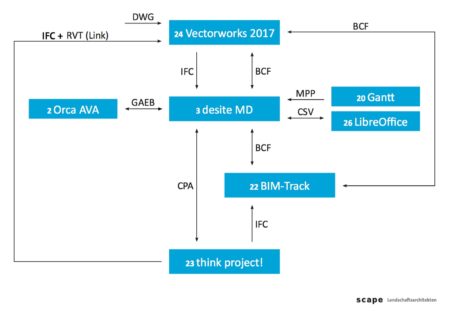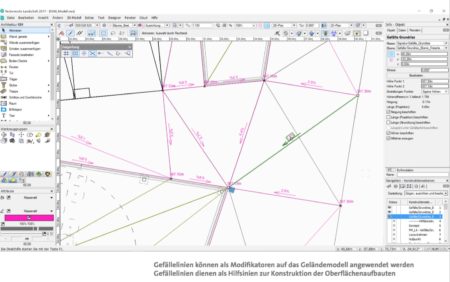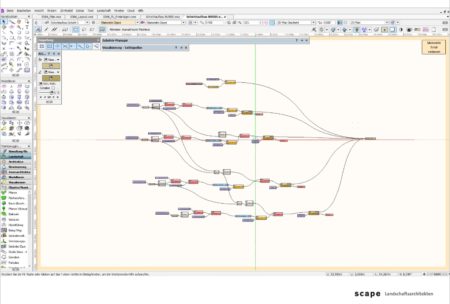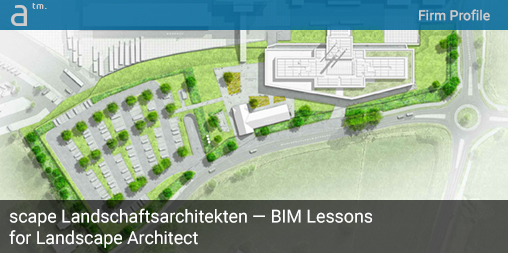TRUTH BE TOLD, YOU DON’T typically hear of a landscape architecture firm jumping out ahead of the BIM learning curve, but that is exactly the case of the scape Landschaftsarchitekten (scape for short) office in Düsseldorf, Germany.
The small firm has developed important learning lessons for landscape architects working on BIM projects led by architects and developers. Founded in 2001 by Matthias Funk, Hiltrud M. Lintel, and Prof. Rainer Sachse, the scape office has just over 20 talented employees who focus the firm’s work on a mixture of project types. “Eighty percent of our projects are urban spaces and parks, and 20 percent are what we call building-related projects, where we are developing landscapes around new buildings,” says Matthias Funk, principal at scape.
The Viega Project—BIM Lessons
In that latter category, one recent project was for a new headquarters and seminar building in Attendorn. Developed for The Viega Group, an internationally active business in the field of mechanical and plumbing technology for sanitary and heating systems, the seminar building itself had an architectural program component devoted to educating customers about the BIM process in the plumbing and HVAC segments of building technology and design. This building was going to literally be about BIM. And it was also going to be designed and built using a full BIM process.
The Crisis of Closed BIM
When the project began, Matthias explains that the mandate was that the project would proceed as a “Closed BIM” project process. Having been a firm that has done many highly technical projects, scape was selected as the landscape architecture firm. But it would soon be apparent that the BIM process imagined for the project would need to change.

An overview of the project showing site and architecture together in a comprehensive site plan. (image: scape / Architosh. All rights reserved.)
It became evident that scape was the best to help on this project. “It worked out well because we had a very good BIM manager on the project team, who was skilled at implementing a BIM Development Plan,” says Matthias.
The team had spent nearly half a year developing a Closed BIM process, but in the end, it was easier to do an Open BIM process.
They spent some time trying to set up a workflow for landscape architecture in Revit, but they couldn’t get it to match their firm’s workflow and requirements.
“The team had spent nearly half a year developing a Closed BIM process, but in the end, it was easier to do an Open BIM process,” says Matthias, who explained that they had to work in Revit and the other mandated tools formulated in the Closed BIM model. “The term Closed BIM in Germany means that all the subcontractors and consultants need to use a specific tool—you cannot just say I like this tool or that tool,” he adds.

scape developed an Open BIM workflow for the entire project. Here is their workflow with Vectorworks Landmark. (image: scape / Architosh. All rights reserved.)
In the end, a closed BIM workflow wasn’t going to work on this project. Instead, they switched to an Open BIM workflow built around IFC.
The Advantages of Open BIM
As mentioned earlier, Matthias said it was just as easy to develop an Open BIM Development Plan in the end. Not only was it easier for the landscape architects to work more optimally in an Open BIM workflow, but it was also easier for the civil engineering firm and others as well.
“Revit is just not specialized enough for the needs of landscape design,” said Matthias. “Our staff discovered that Revit had many ‘workarounds’ to handle things that we just don’t have in Vectorworks Landmark. For example, you had to use Slabs for Streets.”

Vectorworks Landmark shown here from the Viega Project by scape. Vectorworks Landmark excels at handling complex 3D data and the project contained complex height data across the landscape architect’s work. (image: scape / Architosh. All rights reserved.)
Vectorworks Landmark is purpose-built for the needs of landscape architects. Trying to get their staff to work out their firm’s particular workflows in another piece of “mandated software” turned out more challenging than he first thought. “Our staff has over 15 years with Vectorworks,” says Matthias, and you just can’t underestimate the experience they have in this environment.”
Collaboration and Open BIM
Once an Open BIM process was defined for the Viega project things moved along well. “We all made data exchanges through IFC as required by the project,” said Matthias. To help collaboration along, the project participants also used think project!, a cloud-based common data environment that can be used for BIM coordination and management and DESITE MD, an IFC viewer, model checker and information manager.
Vectorworks today has one of the very best 3D engines and is one of the best programs to handle 3D data.
“We would put our IFC models back out on think project! on the web and then the BIM manager made collaboration models from these IFC models in DESITE MD,” added Matthias.
DESITE MD is software from Germany that handles BIM management, including BIM information, quality and project management. scape created their digital terrain models in Vectorworks using its native tools specifically designed for landform creation, streets, parking lots, curbs, planting designs and complete with height data to coordinate with final project site installation requirements. This 3D model as then translated to IFC to integration into the federated BIM model for the project coordination.

scape also developed custom algorithmic design scripts for their work during the project to further automate complex and time-consuming processes. Vectorworks Landmark includes Marionette, its own built-in visual, node-based algorithmic scripting tool for algorithmic and computational design and modeling. (image: scape / Architosh. All rights reserved.)
Taking their site model out through IFC means that the true Digital Terrain Model (DTM) gets translated into a triangulated mesh model. “We don’t have any problems if we interact in this type of environment,” adds Matthias. “Our workflow is setup so that we bring in IFC models from other professionals, and we can load them through IFC into Vectorworks, so they can interact with our true DTM.” This allowed them as landscape architects to make needed adjustments, perform powerful calculations for landform design that are purpose-built features in Vectorworks Landmark, and then reshare their work back through IFC.
next page: BIM for Landscape—Germany Lessons




Reader Comments
Comments for this story are closed